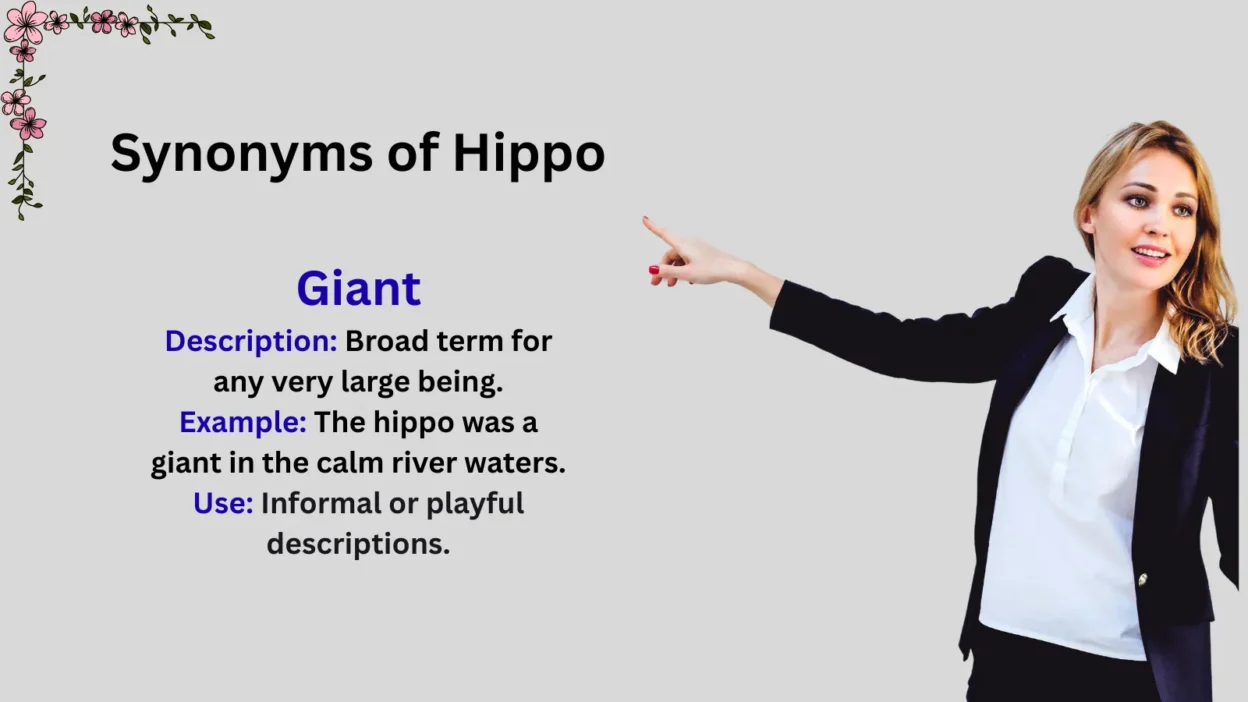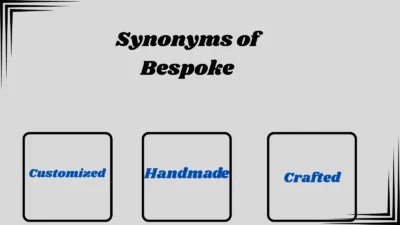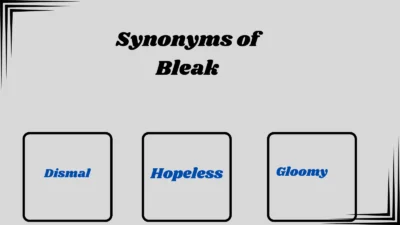Synonyms of hippo, such as hippopotamus, river horse, and water beast, reflect the strength, size, and unique nature of this large African animal. For example, “hippopotamus” is the formal name, while “river horse” comes from the Greek roots of the word, showing its link to water and power. These terms highlight different sides of the hippo—from its scientific identity to its place in culture and nature.
If you’re writing about wildlife, zoology, or storytelling, using the right synonym helps you set the right tone—scientific, poetic, or playful. In this guide, we’ll explore several ways to refer to a hippo and when each fits best.
These synonyms of hippo not only add variety to your writing but also deepen your understanding of this fascinating creature. From biology to folklore, the language around hippos reflects both their might and their charm.
What Does Hippo Mean?
Hippo is short for hippopotamus, a large, mostly plant-eating mammal found near rivers and lakes in Africa. The word comes from Greek—hippos, meaning “horse,” and potamo, meaning “river.”
Depending on how it’s used, hippo can suggest:
- A powerful, heavy animal
- Life around rivers and wetlands
- Playful or friendly imagery in stories
- A symbol of strength and calm power
It’s not just a big animal—it’s a creature that represents both force and peace, living between land and water with timeless grace.
Synonyms & Related Words for Hippo (And When to Use Them)
1. Hippopotamus
Description: The formal term for hippo.
Use: Best for scientific, educational, or formal writing.
Example: “The hippopotamus spends much of its day submerged in water to keep cool.”
2. River Horse
Description: A poetic or historical term derived from the Greek meaning of hippopotamus.
Use: Literary or whimsical contexts.
Example: “The river horse slowly emerged from the misty waters.”
3. Behemoth
Description: Refers to a huge, powerful creature, often metaphorical.
Use: Figurative language to describe something massive or overwhelming.
Example: “The cargo ship was a behemoth compared to the small fishing boats.”
4. Pachyderm
Description: General term for thick-skinned animals like elephants, rhinos, and hippos.
Use: Scientific or descriptive contexts.
Example: “Among the pachyderms, the hippo is surprisingly fast on land.”
5. Giant
Description: Broad term for any very large being.
Use: Informal or playful descriptions.
Example: “The hippo was a giant in the calm river waters.”
6. Colossus
Description: Figuratively emphasizes sheer size and power.
Use: Literary or dramatic effect.
Example: “The colossus of the river seemed to rule over all nearby creatures.”
7. Leviathan
Description: Mythical sea monster, often used metaphorically for large animals.
Use: Figurative or storytelling contexts.
Example: “The leviathan emerged from the depths, dwarfing the boats.”
8. Mammoth
Description: Extremely large creature, evokes prehistoric scale.
Use: Emphasizes size in informal or creative writing.
Example: “The hippo’s body looked mammoth next to the tiny riverbank birds.”
9. Titan
Description: Symbol of immense strength and size.
Use: Figurative language or dramatic narratives.
Example: “In the river, a titan moved with surprising grace.”
10. Juggernaut
Description: A Powerful force or animal that is hard to stop.
Use: Figurative when describing unstoppable size or impact.
Example: “The hippo was a juggernaut, clearing a path through the reeds.”
11. Brute
Description: Highlights the animal’s strength and potential aggressiveness.
Use: Emphasizes power or menace.
Example: “The hippo is no gentle giant—it’s a brute when provoked.”
12. Heavyweight
Description: Suggests both mass and dominance.
Use: Informal, playful, or figurative contexts.
Example: “The river’s heavyweight claimed its territory with ease.”
13. Behemothine
Description: Literary adjective meaning huge or monstrous.
Use: Writing that seeks elevated, descriptive language.
Example: “The behemothine hippo loomed in the late afternoon sun.”
14. Bulk
Description: Focuses on size and mass.
Use: Informal descriptions of physical largeness.
Example: “Its sheer bulk made crossing the river an impressive sight.”
15. Colossal Creature
Description: Emphasizes both size and living form.
Use: Descriptive or narrative writing.
Example: “A colossal creature waded lazily along the riverbank.”
16. Monolith
Description: Figurative term for something enormous and solid.
Use: Creative or literary contexts.
Example: “The hippo appeared like a monolith, unmoving yet imposing.”
17. Gargantuan
Description: Extremely large; emphasizes scale.
Use: Hyperbolic or playful writing.
Example: “A gargantuan hippo splashed into the river.”
18. Heavy Hitter
Description: Informal, suggests strength and impact.
Use: Casual or metaphorical language.
Example: “In river politics, the hippo is the heavy hitter.”
19. Lumbering Beast
Description: Highlights slow, powerful movements.
Use: Narrative or descriptive writing.
Example: “The lumbering beast trudged through the mud.”
20. Massive Mammal
Description: Straightforward description emphasizing size.
Use: Educational or general writing.
Example: “The massive mammal spends most of its time in water.”
21. Large Animal
Description: Neutral, descriptive term.
Use: General contexts, avoids figurative or dramatic language.
Example: “A large animal grazed by the riverbank.”
22. Heavyweight Mammal
Description: Emphasizes both size and biological classification.
Use: Educational, wildlife-focused writing.
Example: “Among heavyweight mammals, the hippo is surprisingly agile.”
23. Beast
Description: Broad term for large or wild animals.
Use: Casual or dramatic writing, sometimes playful.
Example: “The river beast made the tourists hold their breath.”
24. Elephantine
Description: Literally like an elephant, it emphasizes bulk.
Use: Figurative or descriptive contexts.
Example: “The elephantine hippo moved slowly but powerfully.”
25. Amphibious Giant
Description: Highlights the animal’s dual land-water lifestyle.
Use: Scientific, educational, or descriptive.
Example: “This amphibious giant spends nights on land and days in water.”
26. Monster
Description: Can be playful or menacing; emphasizes size or impact.
Use: Figurative or storytelling contexts.
Example: “A river monster emerged from the shadows.”
27. Giant Mammal
Description: Emphasizes both size and classification.
Use: Neutral, factual, or educational.
Example: “The giant mammal can weigh over 3,000 pounds.”
28. Mega-Beast
Description: Informal, emphasizes extreme size.
Use: Casual, creative, or humorous writing.
Example: “The mega-beast wallowed in the shallow water.”
29. River Titan
Description: Combines literal habitat with metaphorical grandeur.
Use: Literary or storytelling.
Example: “A river titan dominated the flooded plains.”
30. Water Buffalo (Figurative)
Description: Comparatively large aquatic mammal; used metaphorically for size.
Use: Figurative or playful, especially in humor.
Example: “The hippo moved like a water buffalo through the reeds.”
How to Choose the Right Synonym
- Context Matters:
- Scientific Writing: Use hippopotamus, pachyderm, massive mammal.
- Literary/Poetic Writing: Use river horse, colossus, leviathan, river titan.
- Informal/Playful Writing: Use giant, mega-beast, heavy hitter, monster.
- Emotional Tone:
- Imposing or Powerful: juggernaut, titan, brute.
- Whimsical or Cute: river horse, lumbering beast.
- Neutral/Descriptive: large animal, giant mammal.
- Cultural or Figurative Use:
- Terms like behemoth, leviathan, and colossus have strong metaphorical or literary associations and may evoke grandeur or awe.
- Casual terms like mega-beast or heavy hitter can be humorous or conversational.
By paying attention to your tone, audience, and purpose, you can select the most effective synonym to communicate precisely what you mean while adding variety and richness to your writing.
Conclusion
Synonyms of hippo help you understand the different ways this large, fascinating animal can be described. From scientific terms like Hippopotamus amphibius to playful or informal alternatives such as river horse or big water beast, each synonym offers a unique perspective.
Knowing these alternatives not only enriches your vocabulary but also allows you to write, speak, or teach about hippos more creatively and accurately.
Understanding the synonyms of hippo gives you the flexibility to communicate effectively and vividly.



